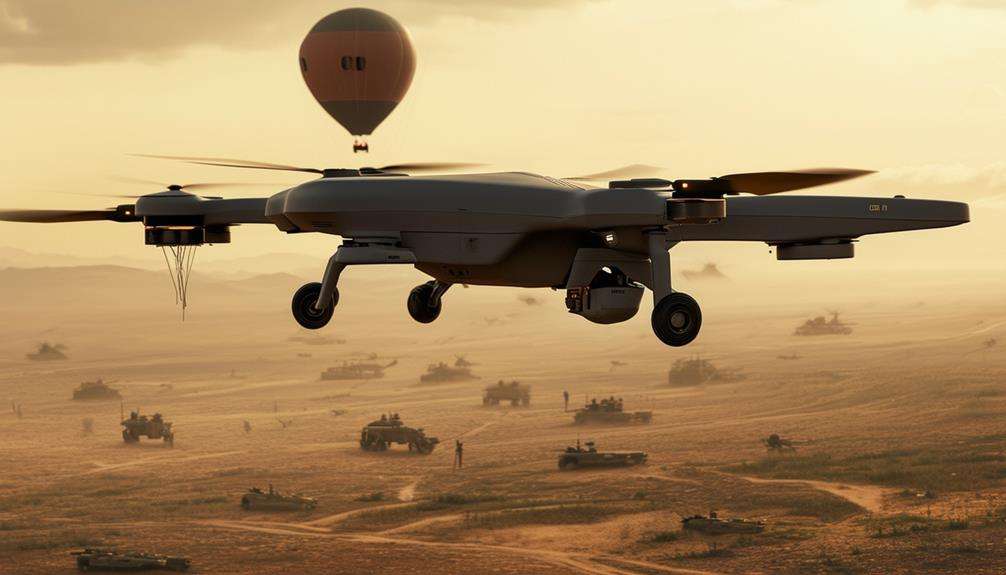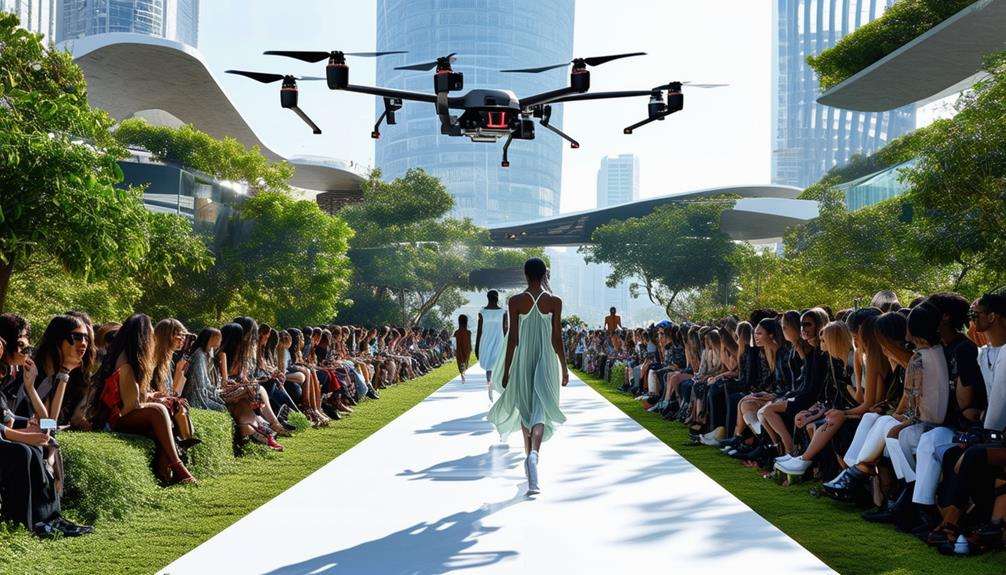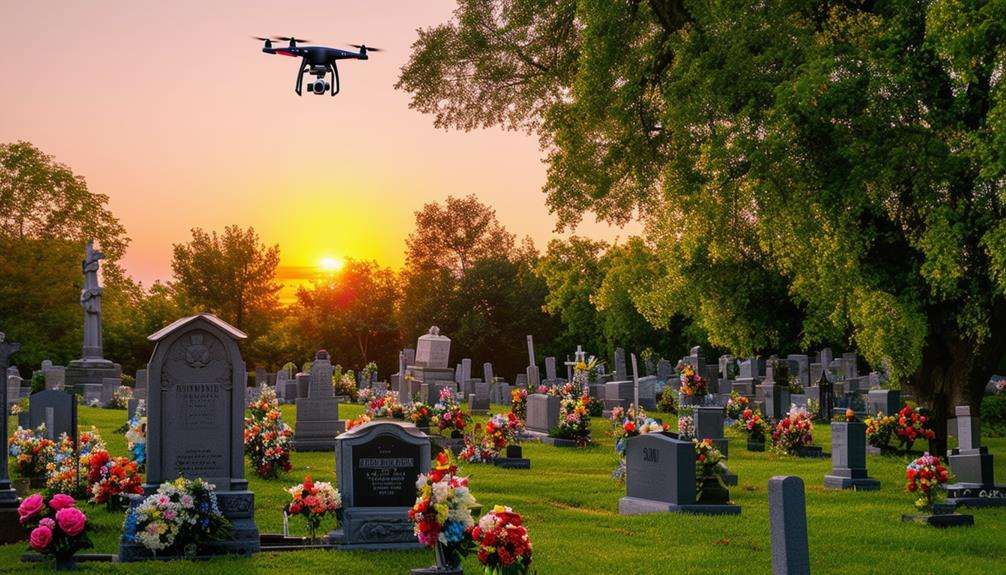Military UAVs: How Unmanned Aerial Vehicles Enhance Modern Warfare
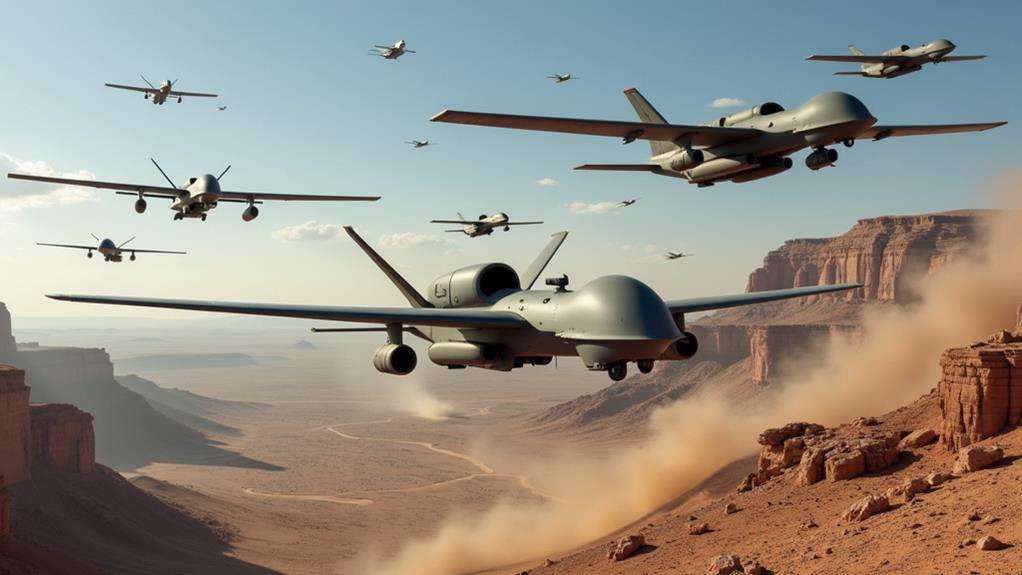
Military UAVs have revolutionized modern warfare by offering capabilities ranging from reconnaissance missions to precision strikes, all while keeping human operators safe. Equipped with advanced sensors and AI, they enable real-time intelligence gathering with unprecedented efficiency. However, challenges such as electronic warfare vulnerabilities and ethical dilemmas must also be considered to fully understand their impact on contemporary conflicts.
Evolution of Military UAVs
How did military UAVs transform from rudimentary tools to indispensable assets in modern warfare? Initially deployed during World War I for aerial observation, UAVs have undergone significant advancements. Early models were unreliable with limited capabilities, but technological innovations have driven their evolution. By the Vietnam War, UAVs played a crucial role in reconnaissance missions, marking a significant technological milestone.
The late 20th and early 21st centuries witnessed rapid development and global adoption of UAVs by military forces. These unmanned systems became essential for intelligence gathering, surveillance, and combat operations. Modern UAVs feature advanced capabilities such as autonomous flight, extended endurance, and stealth, making them vital to contemporary military strategies.
This evolution reflects a strategic shift from manned aircraft to unmanned systems, offering cost-effective solutions and minimizing risks to personnel. Continuous improvements in UAV technology have enhanced their reliability and expanded their operational scope. Today, UAVs are critical for executing complex military missions, highlighting the profound impact of technological advancements on military UAVs.
Tactical Advantages
When assessing the tactical advantages of UAVs, their capability to execute precision strikes stands out, significantly reducing collateral damage. UAVs also collect real-time intelligence, delivering essential data for battlefield decision-making. Additionally, utilizing drones diminishes the risk to pilots, thereby preserving personnel safety while maintaining combat effectiveness.
Precision Targeted Strikes
Why are military UAVs such a game-changer in modern warfare? It's all about precision strikes. UAV technology enables engagement with high-value targets with unprecedented accuracy, minimizing collateral damage and enhancing operational effectiveness. These drones are equipped with advanced sensors and targeting systems that provide real-time intelligence, ensuring strikes hit their intended targets. The integration of AI further sharpens their precision, allowing for faster and more reliable decision-making in critical situations.
Imagine needing to neutralize a high-value target in a densely populated urban area. UAVs like the MQ-9 Reaper can loiter over the target for extended periods, gathering crucial intelligence and waiting for the optimal moment to strike. This capability not only increases the likelihood of mission success but also significantly reduces the risk to civilian lives. Coordinating these precise strikes with ground forces allows for achieving objectives with minimal risk and maximum efficiency.
In essence, UAVs revolutionize targeted operations. Their ability to deliver precision-guided munitions and leverage real-time intelligence makes them indispensable in modern warfare, ensuring effective and safe mission accomplishment.
Real-Time Intelligence Gathering
Military UAVs have revolutionized real-time intelligence gathering, offering unparalleled tactical advantages on the battlefield. Utilizing drones allows the military to conduct continuous surveillance and reconnaissance without risking personnel. Equipped with advanced sensors and cameras, UAVs capture high-resolution imagery and video, enabling precise target identification and comprehensive assessment of battlefield conditions.
The real-time data collected by these drones significantly enhances situational awareness. For example, UAVs like the Bayraktar TB2 have demonstrated their effectiveness in the Ukraine conflict, conducting successful intelligence operations that provided forces with a strategic edge over adversaries. The integration of AI technology into UAVs further amplifies their capabilities. Automated data analysis allows operators to quickly interpret complex information and make informed tactical decisions, maintaining an advantage over the enemy.
Moreover, UAVs relay critical information to command centers, enhancing overall operational tempo. This real-time intelligence ensures military units can swiftly respond to emerging threats or seize new opportunities. By improving situational awareness and providing continuous, high-quality data, UAVs play a crucial role in modern warfare, transforming how military forces operate and maintain superiority on the battlefield.
Pilot Risk Reduction
Remote operations utilizing military UAVs have significantly reduced pilot risk, providing a substantial tactical advantage. These UAVs enable intelligence gathering and targeted strikes without endangering personnel. They are particularly effective in hostile environments where manned aircraft would face severe threats, thereby enhancing operational safety for military forces.
By employing UAVs for reconnaissance and surveillance, the need for ground troops in dangerous areas is diminished, lowering the risk of casualties during combat operations. Armed UAVs, such as the MQ-9 Reaper, can loiter over target areas for extended periods, offering persistent coverage. This reduces the necessity for immediate manned air support, which is often more susceptible to enemy attacks.
The use of UAVs allows for greater precision in combat operations while minimizing exposure. This enhances troop safety and lowers overall mission risk. UAVs have transformed modern warfare by providing a safer, more efficient method for executing high-stakes military tasks, ensuring the achievement of objectives while minimizing dangers to personnel.
Multi-Purpose Use
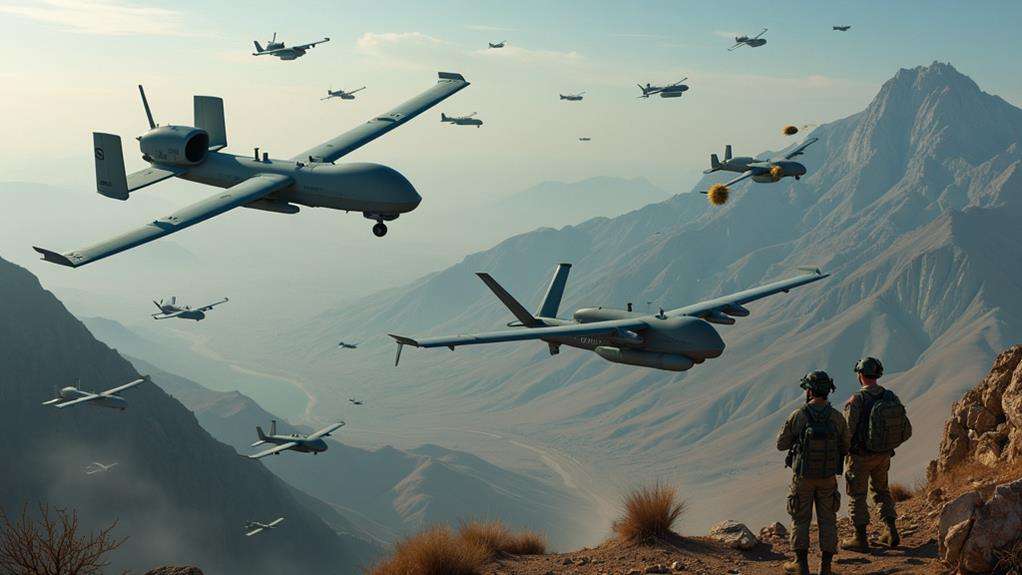
The versatility of military UAVs has revolutionized modern warfare, enabling armed forces to execute a wide array of roles with unprecedented efficiency. UAVs excel in intelligence gathering, combat missions, and electronic warfare, making them indispensable on today's battlefield. For instance, smaller drones like the Bayraktar TB2 have demonstrated remarkable adaptability, contributing to both combat operations and intelligence collection while minimizing risks to personnel.
Drones equipped with electronic warfare capabilities can jam enemy communications, providing a tactical advantage. The integration of AI technology into UAVs further enhances their multi-purpose use, enabling autonomous operations that adapt to changing battlefield conditions and execute complex missions with minimal human oversight. Recent conflicts, such as the Ukraine conflict, have underscored the multi-purpose utility of UAVs in real-time intelligence, combat support, and logistical operations, fundamentally reshaping traditional military strategies.
Here's an overview of the various roles UAVs can perform:
| Role | Example UAV | Key Capability |
|---|---|---|
| Intelligence Gathering | Bayraktar TB2 | Real-time surveillance |
| Combat Missions | MQ-9 Reaper | Precision strikes |
| Electronic Warfare | EA-18G Growler | Jamming enemy communications |
| Autonomous Operations | AI-enabled drones | Adaptability and minimal oversight |
| Logistical Support | Cargo Drones | Supply delivery in conflict zones |
The multi-purpose capabilities of UAVs significantly enhance operational efficiency and effectiveness in modern warfare.
Operational Challenges
While UAVs have revolutionized modern warfare with their multi-purpose capabilities, they also present significant operational challenges that cannot be overlooked. One major issue is the reliability of communication systems. UAVs often rely on line-of-sight communication, which can be disrupted by terrain or electronic warfare tactics. This vulnerability can severely impact their operational effectiveness in combat scenarios.
High-density anti-air environments pose another significant challenge. Large drones like the Bayraktar TB2 are particularly vulnerable in these settings, as they depend on the failure of adversary air defenses to be effective. This makes them less useful in high-intensity conflicts where advanced air defense systems are present.
The complexities involved in the procurement processes also cannot be ignored. Acquiring the latest UAV technology is not always straightforward and can delay deployment, affecting readiness and response times.
Here are three key operational challenges:
- Communication Systems: Susceptibility to electronic warfare and line-of-sight limitations.
- Defensive Tactics: Vulnerability in high-density anti-air environments requiring continuous adaptation.
- Procurement Processes: Delays in acquiring state-of-the-art UAVs, impacting operational readiness.
Additionally, the need for specialized training and interdisciplinary skills for UAV operators underscores the operational challenges in keeping pace with rapid technological innovations.
Ethical Considerations
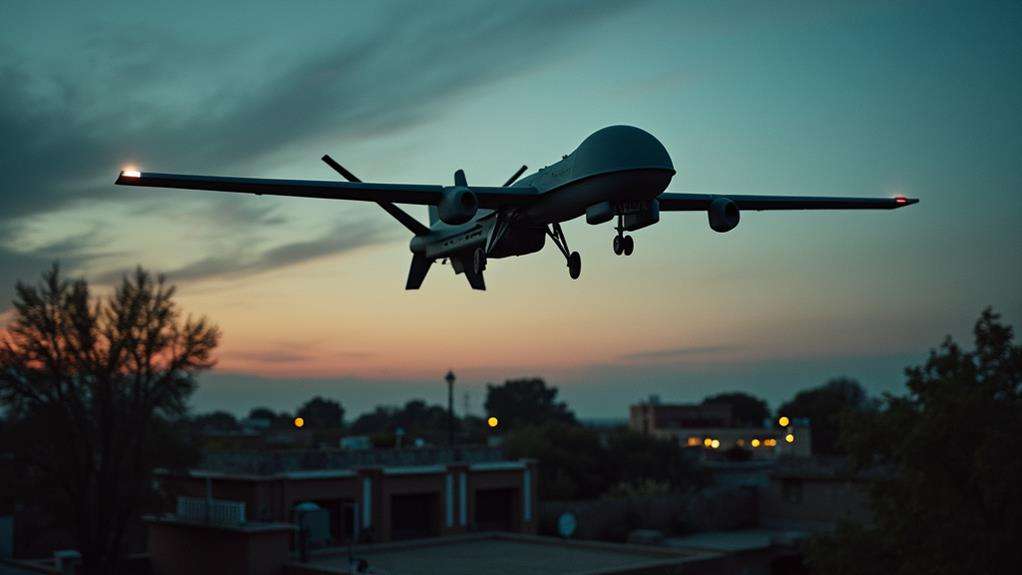
When evaluating the ethical implications of military UAVs, significant concerns arise regarding civilian casualties and the accountability of autonomous decision-making. These drones can execute life-and-death decisions, often without direct human oversight, leading to questions about responsibility when errors occur. Addressing these issues is crucial to ensure UAVs are used responsibly and within ethical boundaries.
Civilian Casualty Concerns
Civilian casualties from military UAV operations spark intense ethical debates, primarily focusing on the human cost of remote warfare. The use of armed UAVs raises significant ethical concerns, particularly when targeted killings result in civilian casualties in up to 90% of cases in some conflict zones. This underscores the urgent need for accountability. Here are three key ethical concerns:
- Collateral Damage and Verification: The lack of transparent oversight complicates assessing collateral damage. Many drone strikes classify civilians as "enemy combatants" without thorough verification, leading to widespread civilian casualties.
- Desensitization in Remote Warfare: Operators distanced from the battlefield may become desensitized to civilian suffering. This desensitization adds another layer of ethical complexity to UAV use.
- Compliance with Humanitarian Law: The proliferation of UAV technology necessitates stricter regulations to minimize civilian harm and ensure compliance with humanitarian law. The psychological impact of drone strikes on local populations can lead to long-lasting trauma, raising further ethical questions about the long-term consequences on civilian communities.
Addressing these ethical concerns is crucial for maintaining accountability and minimizing the human cost of modern warfare.
Autonomous Decision-Making Ethics
Autonomous decision-making in military UAVs raises significant ethical concerns, particularly regarding accountability and the delegation of life-and-death decisions to machines. When AI systems execute combat decisions, the responsibility for their actions often becomes ambiguous, leading to serious consequences, especially in cases of civilian casualties. Unlike human operators, algorithms lack nuanced understanding, increasing the risk of unintended harm.
Ethical frameworks for autonomous UAVs remain underdeveloped, creating a regulatory gap. Without robust regulations, there's a risk of misuse or escalation of force without adequate oversight. The integration of AI in UAVs necessitates thorough ethical discussions on the implications of delegating critical decisions to machines, as these systems lack moral reasoning and empathy, both crucial in combat scenarios.
International humanitarian law struggles to keep pace with rapid advancements in UAV technology, prompting calls for global agreements to establish norms governing the use of autonomous weapon systems. It's essential to consider how these evolving technologies align with existing ethical standards and what new regulations are necessary to ensure their responsible use in warfare.
Regulatory Frameworks
As military UAVs (Unmanned Aerial Vehicles) become more advanced and autonomous, establishing effective regulatory frameworks is crucial for compliance with national and international laws. The rapid advancement of UAV technology has outpaced existing regulations, necessitating proactive engagement from military, industry, and legislative bodies to create comprehensive standards. The U.S. National Defense Authorization Act (NDAA) sets guidelines for UAV operations, emphasizing the need for secure and reliable communication systems to mitigate risks during military missions.
To ensure military UAVs operate effectively while adhering to legal standards, consider the following:
- Update Existing Regulations: Modernize current laws to keep pace with UAV technology, particularly in areas like BVLOS (Beyond Visual Line of Sight) operations.
- Promote Collaboration: Foster ongoing dialogue among legislators, military officials, and industry stakeholders to develop adaptive regulatory frameworks that support UAV integration in military operations.
- Balance Safety and Innovation: Reform regulatory barriers to ensure safety without stifling technological advancements.
Financial Implications
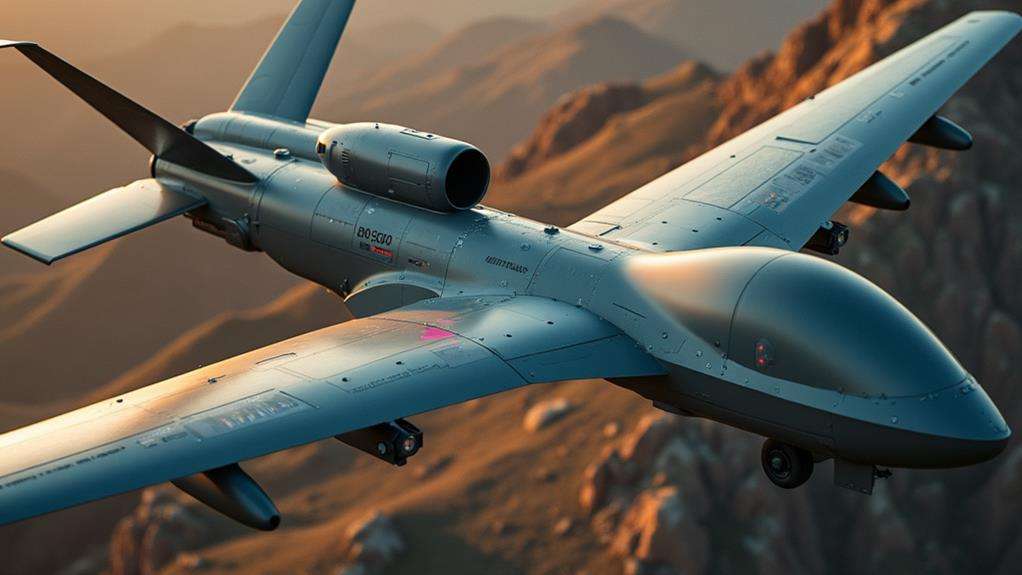
The financial implications of integrating military UAVs extend beyond initial cost savings. By opting for UAVs over traditional aircraft, you're leveraging a cost-effective solution that can reduce operational expenses by up to 50%. This strategy not only conserves financial resources but also reallocates them to enhance military capabilities without compromising effectiveness.
The global market for military UAVs is projected to reach approximately $45 billion, reflecting a growing demand for drone operations. Financial imperatives are driving this adoption, as UAVs facilitate high-volume production and deployment, ensuring greater value for investment.
Countries like Ukraine have demonstrated that even with budget constraints, the strategic use of drones can yield significant operational advantages. Investing in UAVs offers a cost-effective alternative to traditional military assets, enabling nations to achieve strategic objectives more efficiently. Moreover, the affordability of counter-drone systems further enhances the appeal of UAVs, as these systems are often less expensive than the drones they target.
Future Innovations
Imagine a battlefield where drones don't just follow orders but think and adapt in real time. This is the future of military UAVs, driven by cutting-edge innovations. One of the most transformative advancements is the integration of artificial intelligence. AI will enable UAVs to learn and make decisions on the fly, optimizing mission outcomes with minimal human intervention. This adaptability is crucial for future conflicts where rapid response and strategic agility are paramount.
Another game-changer is swarm technology, allowing multiple UAVs to operate in unison, conducting reconnaissance and executing strikes with unprecedented efficiency. This coordinated approach will revolutionize military strategies, making operations more precise and effective.
Directed energy weapons are also on the horizon. These laser-based systems will enable UAVs to deliver high-energy strikes with pinpoint accuracy, eliminating the need for traditional munitions and potentially transforming combat dynamics.
Here are three key innovations to watch for:
- AI-Enhanced Autonomy: Enabling UAVs to learn and adapt in real time.
- Swarm Technology: Facilitating coordinated drone operations for superior battlefield efficiency.
- Directed Energy Weapons: Providing precise, high-energy laser strikes.
These advancements will not only shape military strategies but also redefine the landscape of future conflicts.


